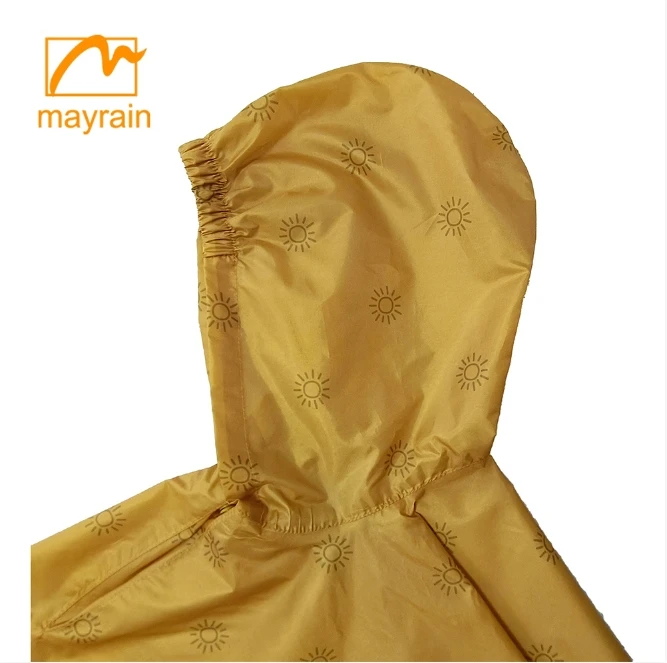 rainwears@163.com may@may-rain.com
rainwears@163.com may@may-rain.com Mon to Friday: 8.00 am - 7.00 pm
Mon to Friday: 8.00 am - 7.00 pm
rain wear for bike
The Importance of Rain Wear for Biking
Cycling is a fantastic way to stay fit, reduce carbon footprints, and explore the outdoors. Whether you're commuting to work, enjoying a weekend ride, or tackling challenging terrains, it's an exhilarating experience. However, one major challenge cyclists often face is the unpredictable nature of weather, especially rain. Therefore, investing in quality rain wear is essential for every cyclist.
Why Rain Wear Matters
Cycling in the rain can be both uncomfortable and unsafe. Wet weather can lead to decreased visibility, slippery roads, and increased fatigue due to cold and damp conditions. Without proper rain wear, cyclists may quickly become soaked, which not only affects their comfort but also their performance. When you're cold and wet, muscle function declines, reaction times slow, and concentration falters—all critical components for safe biking.
Moreover, rain wear protects cyclists from wind and moisture, ensuring that they stay dry and warm. High-quality rain gear helps to maintain body temperature and can prevent the onset of hypothermia in cooler weather. Thus, effective rain wear is fundamental to enhancing both safety and comfort during rides.
Choosing the Right Rain Wear
When selecting rain wear for biking, there are several crucial factors to consider
1. Material Look for gear made from waterproof and breathable materials. Gore-Tex and similar fabrics offer excellent water resistance while allowing sweat to escape, ensuring that you remain dry on the inside as well.
2. Fit Proper fit is vital for comfort and effectiveness. Loose clothing can catch the wind, creating drag and making it harder to pedal. However, it shouldn't be too tight either, as this can restrict movement. Opt for designs specifically tailored for cycling that offer a balance of comfort and aerodynamics.
3. Visibility Low visibility is a significant concern when riding in the rain. Choose rain wear that includes reflective elements or bright colors to ensure that you stand out to drivers and other cyclists.
4. Pockets and Ventilation Adequate storage can be helpful for carrying essentials, while ventilation features can help regulate temperature and moisture control, enhancing comfort during longer rides.
rain wear for bike

5. Durability Since cycling gear can experience wear and tear, particularly in adverse weather conditions, investing in durable rain wear is wise. Check for reinforced seams and high-quality zippers that can withstand the rigors of outdoor activities.
Essential Rain Wear Items
To stay adequately protected during rainy rides, cyclists should consider the following essential items
- Rain Jacket A lightweight, waterproof jacket with ventilation zippers for airflow is a must-have. Look for features like adjustable hoods and cuffs for a snug fit.
- Rain Pants Waterproof cycling pants can keep your legs dry and are often designed to fit comfortably over cycling shorts. Consider options with zippers for easy removal.
- Shoe Covers Keeping your feet dry is crucial for comfort. Waterproof shoe covers prevent water from seeping in while also providing extra insulation.
- Gloves Waterproof gloves help maintain grip and warmth, keeping your hands agile even in wet conditions.
- Helmet Cover A helmet cover can protect your head from rain and improve visibility with reflective materials.
Conclusion
In essence, rain wear is an indispensable part of any cyclist’s gear, particularly for those who ride frequently or in regions with unpredictable weather. The right rain gear not only enhances comfort and improves performance but also plays a critical role in ensuring safety while cycling. So, whether you’re embarking on a short commute or a long weekend ride, don't overlook the importance of quality rain wear—it can mean the difference between an enjoyable adventure and a soggy ordeal. Embrace the rain, gear up properly, and keep pedaling rain or shine!
-
Silver Printed Women’s Jacket – Stylish, Lightweight & Trendy Outerwear
NewsJul.30,2025
-
Fashionable Design Long Raincoat Rain Poncho Waterproof Polyester
NewsJul.30,2025
-
High Lighting Reflective Rain Jacket Windbreaker Safety Jacket for Adult
NewsJul.29,2025
-
Disposable PE Rain Poncho - Lightweight, Waterproof, Easy to Carry
NewsJul.29,2025
-
Stylish Lady Coat Women Jacket – Trendy & Elegant Outerwear
NewsJul.29,2025
-
Full Printing 100% Waterproof Wearable Striped Polyester Fashion Windproof Raincoat
NewsJul.29,2025































